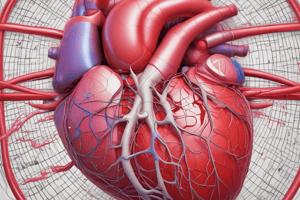Podcast
Questions and Answers
What is the average amount of blood the heart pumps per minute?
What is the average amount of blood the heart pumps per minute?
4.5-5.7L
Where is the heart located?
Where is the heart located?
Mediastinum between the lungs
What controls the heart rhythm?
What controls the heart rhythm?
Medulla oblongata
Which factors affect heart rate?
Which factors affect heart rate?
The two phases of the cardiac cycle are ______ and ______.
The two phases of the cardiac cycle are ______ and ______.
What is the equation for blood pressure?
What is the equation for blood pressure?
What causes atherosclerosis?
What causes atherosclerosis?
What are the symptoms of stage II claudication?
What are the symptoms of stage II claudication?
Mean Arterial Pressure (MAP) is calculated as: (1 x systolic) + (2 x diastolic) / ______.
Mean Arterial Pressure (MAP) is calculated as: (1 x systolic) + (2 x diastolic) / ______.
Which heart sound corresponds to the closure of the AV valves?
Which heart sound corresponds to the closure of the AV valves?
Flashcards are hidden until you start studying
Study Notes
Heart Anatomy and Physiology
- The heart is a fist-sized muscular organ situated in the mediastinum between the lungs.
- It pumps approximately 4.5-5.7 liters of blood per minute, with a stroke volume of 60 mL per beat.
- The heart is the first organ to receive oxygen-rich blood.
- It possesses both mechanical and electrical properties, with rhythm regulated by the medulla oblongata.
- Heart rate is influenced by the autonomic nervous system:
- Sympathetic stimulation involves catecholamines.
- Parasympathetic stimulation is associated with the vagus nerve.
- Baroreceptors monitor blood pressure, while peripheral chemoreceptors detect hypoxemia.
Mechanical Properties of the Heart
- Maintains perfusion to body tissues.
- The cardiac cycle consists of two phases:
- Systole: heart contraction.
- Diastole: heart relaxation.
- Blood pressure (BP) formula: BP = cardiac output (CO) x total peripheral resistance (TPR).
- Components of CO: heart rate (HR) and stroke volume (SV).
- Preload refers to blood returning to the heart, causing chamber stretch.
- Afterload is the pressure that ventricles must overcome during contraction.
- Contractility indicates the strength of heart muscle contraction.
- Blood pressure expressed as: BP = Systolic / Diastolic.
- Mean Arterial Pressure (MAP) formula: MAP = (1 x systolic + 2 x diastolic) / 3.
Heart Sounds
- S1: closure of atrioventricular (AV) valves, described as "lub."
- S2: closure of semilunar valves, described as "dub."
- S3: ventricular gallop, described as "lub-du-dub," may indicate volume overload in females.
Aneurysms
- Most common cause: atherosclerosis. Other causes include syphilis, Marfan’s syndrome, Ehlers-Danlos syndrome, and blunt trauma.
- Types of aneurysms:
- Fusiform
- Saccular (Berry)
- Mycotic (due to infection)
- Common locations:
- Abdominal Aortic Aneurysm (AAA)
- Thoracic Aneurysm
- Cerebral Aneurysm
Symptoms and Stages of Aneurysms
- Often asymptomatic; may present with dull, gnawing abdominal/back/flank pain.
- Symptoms may include:
- Pulsation in the upper abdomen.
- Bruit (abnormal sound).
- Claudication and rest pain categorized in stages:
- Stage I: Asymptomatic
- Stage II: Claudication (pain with exertion)
- Stage III: Rest Pain (pain felt in toes, forefeet, and heels)
- Stage IV: Necrosis/Gangrene (tissue loss)
- Other symptoms: loss of hair; skin may appear dry, scaly, dusky, pale, or mottled; thickened skin.
Risk Factors for Aneurysms
- Prolonged venous hypertension and valvular damage can lead to edema, stasis, and decreased tissue perfusion.
- Additional risks include prolonged standing/sitting, obesity.
Studying That Suits You
Use AI to generate personalized quizzes and flashcards to suit your learning preferences.



